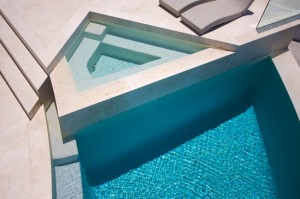Achieving the ideal filtration flow rate for a swimming pool with the least amount of energy consumption is made possible by variable speed pool pumps. Variable speed pool pumps are equipped with Permanent Magnet Motors (PMM) unlike single speed pumps which are driven by Induction motors. These pumps use permanent magnets to create a magnetic field between the rotor and the windings similar to the motors used in hybrid cars. Efficiency is delivered by magnets working to spin the rotor as opposed to a creating a magnetic field in the rotor with a standard induction motor that requires additional electricity.
Installing a Variable Speed Pool Pump
In comparison to single speed pumps which use induction motors, motor designs using PMM can achieve efficiencies of up to 90%. The average single-speed pumps have efficiency ratings between 30% and 70%. As for flow rates, the PMM pumps can produce the same gpm flow rate as single-speed induction motors but use significantly less power.
Energy Efficiency of Variable Speed Pool Pumps
Efficiency is achieved by programming the PMM pump to desired flow rates depending on usage and condtion of the pool A single speed pool pump in contrast is set to operate at a set flow rate even when the required flow rates may be a lot lower. The variable speed pump can be slowed down to the optimum required flow rate thereby conserving energy. The physics behind this efficiency of the PMM pumps is explained by the Pump Affinity Law. The savings are achieved by operating at lower speeds which in turn drops the power consumption. The table below demonstrates the results of this law.
Pump Affinity Law
Speed(rpm) | Flow(gpm) | Power(W) |
3450 | 66 | 2,000 |
3000 | 55* | 1157 |
2400 | 44 | 593 |
1800 | 33 | 250 |
*A reduction in 450 rpm almost unnoticed in the application, cuts the power almost in half. | ||
An example cited by the Department of Energy Publication “Measure Guideline: Replacing Single-Speed Pool Pumps with Variable Speed Pumps” dated May 2012 illustrates how replacing a single-speed pump with a variable speed pump can create significant energy savings.
The average residential swimming pool contains 25,000 gallons of water and has a suggested turnover rate of 24 hours. A single-speed pump drawing 2,000 watts, operating at 3,450 rpms and generating a flow rate of 66 gallons per minute can turn over the entire 25,000 gallons of water in roughly 6.3 hours.
(25,000 gallons / 66 gpm) /60 minutes = 6.3 hours
At this rate the single-speed pump would consume 12,600 watt hours or 12.6 kWh per day, to turn over the pool.
6.3 hours x 2,000 watts = 12,600 watt hours (12.6 kWh)
However, because of the Pump Affinity Law, slower flow rates create greater energy savings. In the field, a variable speed pump set at a flow rate of 22 gpm will draw 116 watts and turn the pool over in 19 hours but only consume 2.2 kWh of electricity.
(25,000 gallons / 22 gpm) /60 minutes = 19 hours – 19 hours x 116 watts = 2,200 watt hours (2.2 kWh)
This is a savings of 10.4 kWh per day, or approximately 3,796 kWh per year. The average retail price of electricity to residential customers in California, where there are an estimated 1.1 million in ground pools, is 14.8 cents per kilowatt-hour. Following this example, the homeowner could realize a savings of $561 annually on their electric bill.
